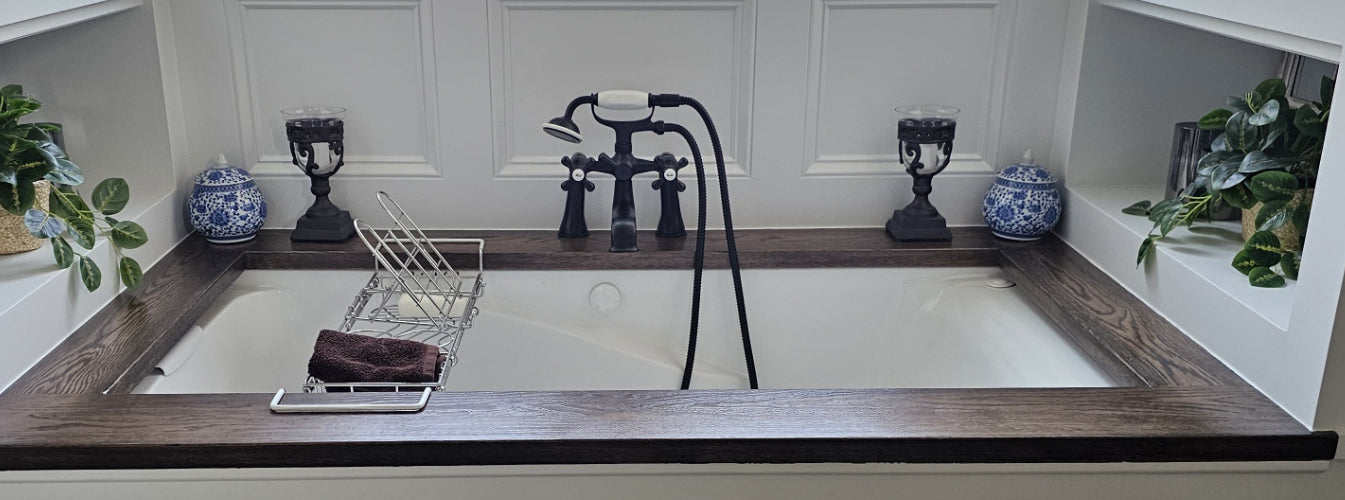Get [PRO] Pricing
Get [PRO] Pricing

Roman tub faucets are popular for homeowners seeking an elegant and stylish option for their tubs. With a wide range of styles and designs available, it's essential to understand the features and benefits of a Roman tub faucet before making a purchase. This guide will outline key considerations when selecting a Roman tub faucet and highlight the offerings from Kingston Brass, a reputable provider with options to suit various design preferences.
Roman tub faucets come in three main installation types: deck-mounted, wall-mounted, and freestanding.

Deck Mounted: These faucets are installed on a horizontal surface, either on pre-drilled holes on the tub itself or the deck surrounding it. The pre-drilled holes on tubs can vary between 7" and 8". Suppose your tub is a drop-in style, installed on a platform built by your contractor. In that case, you have more flexibility in selecting a deck-mounted Roman tub faucet. When choosing a deck-mounted faucet, consider the height of the tub's edge. Traditional tubs often have a lip measuring 3" or 4" in height, so selecting a faucet with a high arch spout is recommended.

Wall Mounted: These faucets offer an alternative when space is limited. Suppose you don't have a large enough deck to accommodate a deck-mounted faucet. In that case, wall-mounted options can be installed using a valve inside the wall. Some wall-mounted faucets do not allow for a handheld shower. Still, if you prefer a traditional look, vintage-style tub fillers are available. These can add an elegant touch to your tub ensemble. Some wall-mounted faucets are designed with integral handheld showers, often referred to as "telephone showers."

Freestanding: A freestanding tub faucet is the most suitable option in cases where neither deck nor wall mounting is feasible, such as with freestanding tubs that lack space on the edge or are too far from the wall. These faucets are available in traditional and contemporary styles and generally include handheld showers in their design. Installing freestanding tub faucets requires careful planning, as the water supply pipes must be plumbed into the floor.

In addition to considering the aesthetics, several practical factors should be considered when choosing a deck-mounted Roman tub faucet. Ensure that the spout is high enough to clear the edge of the tub. Check the width of the handle and spout bases to ensure they fit comfortably on the deck. Verify that there is enough space on the deck to accommodate the faucet. Another critical factor is the projection or distance between the base of the spout and the tip of the fixture. It should project far enough into the tub to allow water to flow without spilling outside.

With wall-mounted faucets, the primary consideration is the length of the spout. Since these faucets can be installed at any height, ensure that the spout projects into the tub without being excessively long, which could pose an obstacle and a safety hazard.


Height and projection are crucial when choosing a freestanding Roman tub faucet, as it will be installed on the floor. Consider the height of the tub when selecting an appropriate faucet. Additionally, take note of the installation method required. Some models may require access below the floor or the construction of a platform to house the mounting hardware and supply line connections. Manufacturers often provide measurement charts to assist with planning, and it is advisable to read the installation instructions thoroughly to ensure proper planning.
The primary function of Roman tub faucets is to fill the tub quickly. Therefore, the maximum flow rate is an important consideration. Ideally, a Roman tub faucet should provide a flow rate of 7 gallons per minute (GPM) or more. At the same time, the hand shower is usually restricted to a flow rate of 1.8 GPM or less.
By considering these factors and exploring the offerings from Kingston Brass, homeowners can select a Roman tub faucet that enhances the beauty of their bathroom while meeting their functional needs.